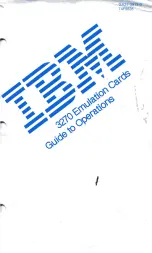
39
Allocation Method Overview
Section 4-1
4-1-2
Allocation Procedure
Follow the two steps below to allocate I/O for remote communications
between the master and DeviceNet Communications Unit.
Step 1: Set the Slaves
Set in the DeviceNet Communications Unit which Temperature Controller data
or DeviceNet Communications Unit data to allocate in the Master. Use either
of the following two methods (1 or 2) to set the data allocation method.
Note
1.
When a CS/CJ-series DeviceNet Unit is used, the IN Area can be divided
into two areas (IN Area 1 and IN Area 2). Any allocation data from the list
of parameters can be selected and allocated in each area. (For example,
operation data and status data can be separated and allocated into differ-
ent locations.) To use this function, however, set two connection methods
between the master and DeviceNet Communications Unit under User Set-
up in the Edit Device Parameters Window for the master. For details, refer
to
Setting Connections when Dividing IN Area in Two
on page 75.
2.
The size of allocated data is determined according to the allocation meth-
od used, as shown in the following table.
Step 2: Allocate Data
in the Master
Specify the I/O memory of the master (CPU Unit) to allocate for the data
determined in step 1. Whether the setting for allocating data in the master is
set to simple I/O allocation or allocation from the Configurator, either of the fol-
lowing two methods can be used.
• Fixed allocations
Method for setting
allocation data
DIP switch
pin 1
Contents
Applications
1) Simple I/O allo-
cation
ON
The predetermined set of
parameters is automati-
cally set.
Used to allocate in the master basic data only, such
as the Temperature Controller SPs, PVs, and alarm
outputs.
2) I/O allocations
from the Configu-
rator
OFF
The Configurator is used
to select any data for allo-
cating in the master from
the list of parameters.
• Used to allocate parameters and statuses in the
master other than the Temperature Controller SPs,
PVs, and alarm outputs.
• Used to allocate data in any order.
• Used to allocate in the master only the data that is
always required for remote I/O communications,
without allocating data that is not required.
• To divide the IN Area into two areas for allocating
data (see note 1).
Setting
method
Number of
allocated blocks
Size of allocated data
Simple I/O
allocation
IN Area: 1 block
OUT Area: 1
block
• TC2 Selected (DIP switch pin 2 OFF):
IN Area:
16 to 46 words (32 to 92 bytes)
(= 16 + n × 2 words)
OUT Area: 8 to 38 words (16 to 76 bytes)
(= 8 + n × 2 words)
• TC4 Selected (DIP switch pin 2 ON):
IN Area:
26 to 86 words (52 to 172 bytes)
(= 26 + n × 4 words)
OUT Area: 14 to 74 words (28 to 148 bytes)
(= 14 + n × 4 words)
n: The value set as the highest communica-
tions unit number (0 to F hex: 0 to 15 decimal).
I/O alloca-
tions from
the Configu-
rator
IN Area: 1 or 2
blocks
OUT Area: 1
block
IN Area: 0 to 100 words (0 to 200 bytes)
OUT Area: 0 to 100 words (0 to 200 bytes)
(Depends on the quantity of allocation data
selected.)
Содержание EJ1 - 07-2008
Страница 1: ...DeviceNet Communications Unit for EJ1 Temperature Controllers Cat No H155 E1 02 OPERATION MANUAL...
Страница 2: ...DeviceNet Communications Unit for EJ1 Temperature Controllers Operation Manual Revised July 2008...
Страница 3: ...iv...
Страница 19: ...xx...
Страница 33: ...14 Initial Temperature Controller Settings Section 1 4...
Страница 53: ...34 Wiring the Temperature Controllers Section 3 4...
Страница 101: ...82 Ladder Programming Examples Section 4 6...
Страница 143: ...124 Sending Explicit Messages Section 6 5...
Страница 155: ...136 Message Communications Characteristics Section 7 2...
Страница 163: ...144 Maintenance Section 8 2...
Страница 189: ...170 Allocation Numbers for Configurators Manufactured by Other Companies Appendix B...
Страница 197: ...178 Index...
















































